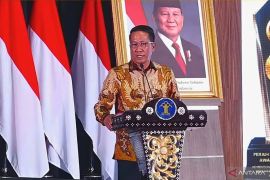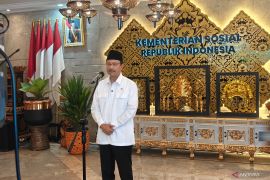Ronald Apriliyanto Halim, a researcher at Defl University of Technology (TUD), the Netherlands, made the remark recently while giving a presentation at a colloquium organized by the Student Association of Indonesia (PPI) Delft on the strategic analysis towards the Indonesian sea port development with global spatial patterns of goods transportation.
"Indonesia`s geographical location makes the country a meeting point of sea transportation, especially for cargo ships," said Ronald, who deals with transportation and logistics research and is also a doctorate candidate at TUD.
Indonesia, especially with some of the islands of Sumatra, near the territorial waters of the Malacca Strait, is a strategic location for the ships that sail to and from countries located in the northern Pacific Ocean such as China, Japan and Korea.
Even the shipping lines that have been developed over thousands of years link the East and Southeast Asian countries with the ones located in the Indian Ocean waters to the Middle East, African, European and American continental countries.
"Though narrow, the Malacca Strait is an efficient shipping route for the ships sailing from the east to the west or vice versa," Ronald noted.
According to him, if ships do not sail passing through the point, the trip will take a while and even increase the cost.
"Of course, this is not desirable for any of the parties involved. Moreover, if the ships transport commodity trading are taken into account all aspects are related to the cost," Ronald added.
Indonesia`s opportunities
The Malacca Straits shipping lanes are included in the territories of three countries; Indonesia, Malaysia and Singapore.
"So far it is Singapore that has been successful in managing the potential geographic shipping lanes in the Malacca Strait," noted Ronald, who is currently working on his doctoral research with the main topic of the development of cargo logistic/global charge model that can be used to analyze the impact of the world economic changes in the global spatial patterns of goods transport.
Currently, it is estimated that 90 thousand kTEU (kilo twenty-foot equivalent units) to be accommodated by the Port of Singapore (PSA). One TEU is equivalent to the capacity of the cargo container size 6.1 by 2.4 meters.
However, with the current capacity of 24 thousand seven hundred kTEU, the Port of Singapore will face serious challenges in 2017 due to the country`s limited area. Consequently, the space available at the port will not be able to meet the shipping needs of sea transport.
"Even for the existing port development, it is almost impossible," Ronald said.
By 2030, it is estimated that 90 million TEU will pass through the Malacca Strait and will not easily be accommodated by PSA. This is an opportunity for Indonesia, including the government and investors, to develop the port to meet the demands for the cargo ships cruise market, he added.
Batu Ampar
Ronald explained that Indonesia`s port near the Malacca Straits, which is now sufficiently developed, is Batu Ampar located in Batam Island, Riau Island province, 18 kilometers south of Singapore.
"The location of Batu Ampar port is strategic to the international shipping routes," said Ronald, who specializes in transportation, infrastructure and logistics (TIL) and modeling, simulation and gaming (MSG).
In contrast, Singapore`s total land area is only 710 square kilometers, and land is an important issue in the development of the port. Indonesia does not experience such a problem. Batam Island has an area of 715 square kilometers, while Indonesia has 1,919,440 million square kilometers.
"It is a great potential for Indonesia in addition to its strategic position in the Malacca Strait," noted Ronald, who has completed his undergraduate program at the University of Pelita Harapan(UPH), Tangerang, Indonesia.
He explained that the value of exports goods from Batam now reached US$5.89 billion from 611 foreign companies coming to the Batu Ampar port. Until the end of 2007, the number of foreign companies using this port was 950.
The main sea port in Batam Island has a cargo capacity of 70 thousand TEU containers, while the actual demand in 2005 reached 200 thousand TEU.
The development of the Batu Ampar plan targets the cargo capacity improvement of 900 thousand TEU and 2 million container capacity with an investment of US$105 million.
"This investment includes the dredging work, construction of container ports, reclamation and gantry," Ronald said.
Cooperation
Currently, the state-owned company Pelabuhan Indonesia (Pelindo) II is planning to establish a partnership with Compagnie Maritime D`affrtement-Compagnie Generale Maritime (CMA-CGM), a shipping and transport company from France, to build and manage the terminal container of Batu Ampar.
According to Ronald, the Indonesian government`s cooperation in this regard through the state-owned company Pelindo II with a foreign investor is a step to accelerate the realization of the development of Batu Ampar as an international cargo port.
"The construction of Batu Ampar port will increase its capacity so it will be able to meet the demands of the world cargo market that will rapidly grow in the coming days. Besides, this port can also strategically compete with Singapore, which exploits the potential of the Malacca Straits shipping lanes but has constraints in terms of the expansion of the port areas," he said.
However, with the cooperation involving foreign parties the government must always retain the ownership and management rights of the Batu Ampar port so that this investment remains profitable for Indonesia.
"All forms of contracts and cooperation between Indonesia and the stakeholders, especially those from outside such as the World Bank and other foreign companies should always be supervised and controlled so that we have nothing to lose," he said.
The investment and cooperation between the Indonesian government and the local, national and international companies are vital for sustainable development and the growth of Batu Ampar and other ports in Indonesia.
(LWA/INE/KR-BSR/S012)
Reporter: Libertina Widyamurti Ambari
Editor: Jafar M Sidik
Copyright © ANTARA 2012










